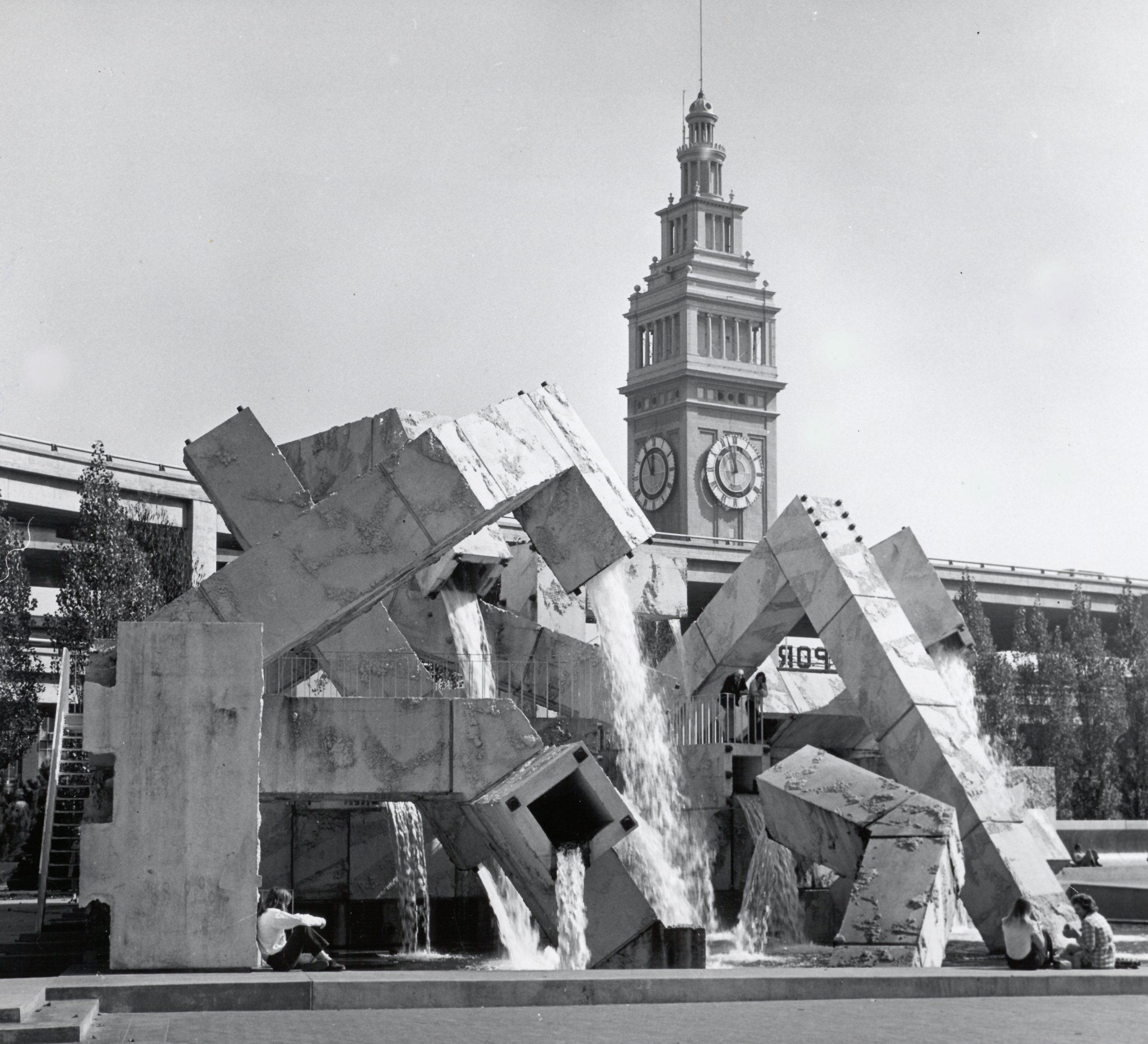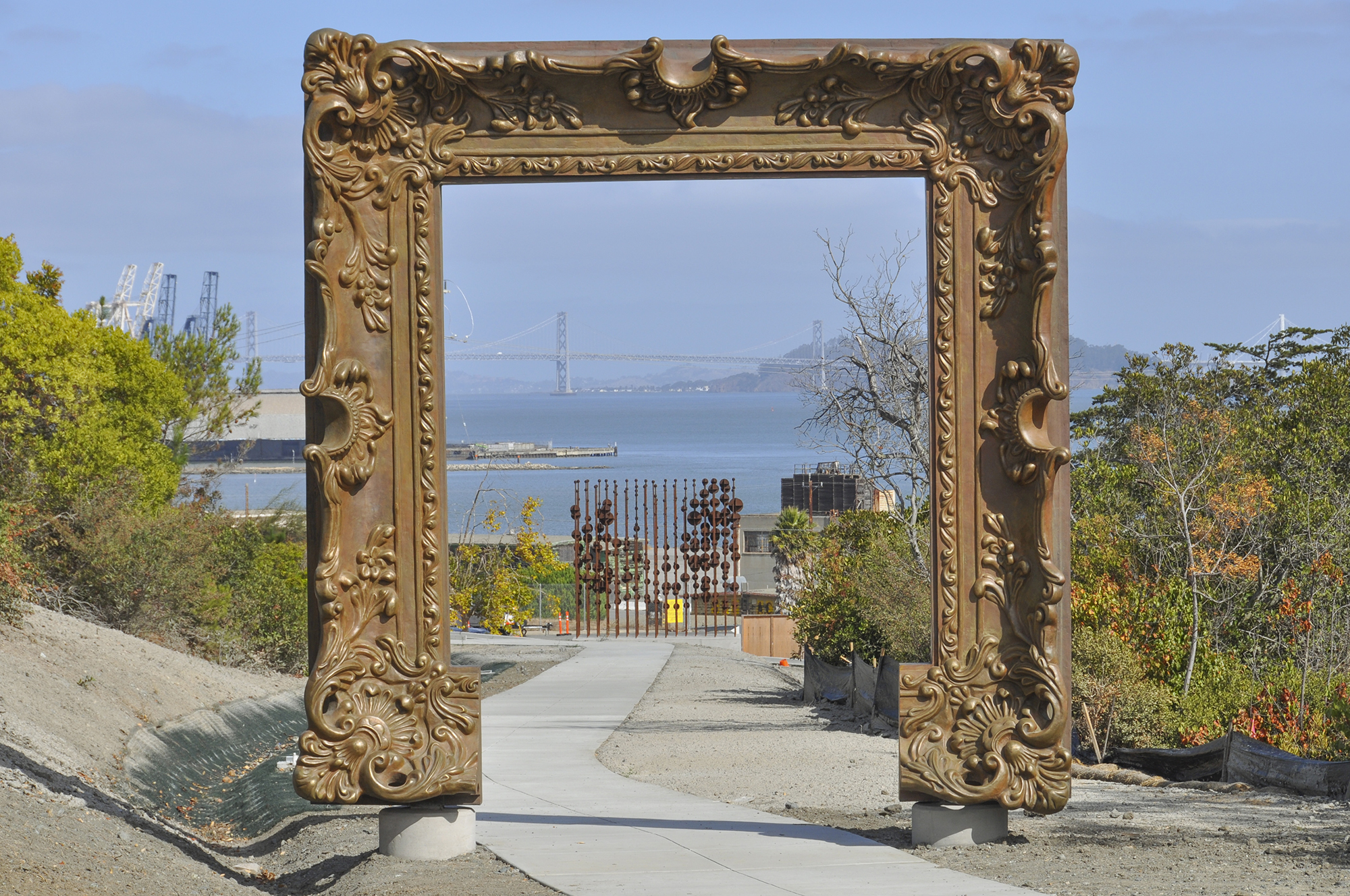
About Place: How Public Art Tells the Story of San Francisco
By Max Blue
Public art has been a hot topic for San Franciscans this year. From the controversial large-scale sculpture of a naked woman in Embarcadero Plaza to the battle over the proposed removal of the nearby Vaillancourt Fountain, the City has been grappling with its civic responsibility to its artworks – and, by extension, its citizens. But a question central to the debate seems to have gone unanswered: What makes good public art?
I know what makes bad public art. The recently proposed Big Art Loop is a shining example. A partnership between the Sijbrandij Foundation and art agency Building 180 to place 100 large-scale (over 10 feet-tall) temporary outdoor sculptures around the City over the next three years. About 10 have been installed at the time of writing, many of which debuted at Burning Man and have been in storage since. The most prominent piece so far is “R-Evolution” – the big naked lady in front of the Ferry Building. San Franciscans have responded to the Big Art Loop with mixed feelings. The debate drew national attention. I’m bearish on it.
Then there was the issue of the Vaillancourt Fountain, also at Embarcadero Plaza, being torn down. On November 3rd, the San Francisco Arts Commission (SFAC) voted 8-5 to remove and store the fountain, which had been deemed a public safety hazard. I loved the fountain and thought it exemplified public art done right. Its rough geometry clashed with the brickwork of the surrounding Lawrence Halprin plaza and meshed with the backdrop of skyscrapers in exciting and unexpected ways. It was a place of congregation for skateboarders the world over and a site of protest for San Franciscans.
You could say it’s a matter of taste, and I can admit that taste is subjective. It certainly isn’t for me, though what bothers me most isn’t the aesthetics of these sculptures but the ethos behind their placement. At its best, public art reflects and elevates its surroundings. The seamless expression of site specificity in an artwork’s execution can be the difference in the success of an artwork – subsequently impacting the surrounding civic area. Site specificity includes a range of definitions in itself. It can mean the ways in which the artwork responds to its surroundings or the history of its physical location as well as the community its existence serves. These meanings, too, can be multi-layered.
“Being site specific is hugely important – whatever that means to that artist,” said Dorka Keehn, an artist and art advisor specializing in public art, who also served on the SFAC from 2010 to 2021, where she chaired the Visual Art Committee. “Whether that means historically or culturally, there has to be some context about who that work speaks to at that site.” In 2008 Keehn collaborated with Brian Goggin to make “Language of the Birds” a sculpture featuring several book-shaped solar lamps suspended from wires above the intersection of Columbus and Broadway Avenues in North Beach, across the street from City Lights Books. The first solar-powered public artwork in the country, the design process included significant community engagement and collaboration with members of the nearby neighborhoods and researching books by authors from those communities, including in Italian and Chinese. Phrases from those books adorn the ground beneath the sculpture.

"Language of the Birds," courtesy Brian Goggin and Dorka Keehn
Over the last decade, Keehn has worked with private developers to place public art to meet their Art Enrichment Ordinance requirements. Colloquially known as the “two-percent-for-art program” the ordinance requires developers to allocate two percent of construction costs of capital improvement projects towards public artwork, administered and overseen by the SFAC. Keehn’s high-profile placements include Jim Campbell’s “Day for Night,” atop the Salesforce Tower, and Leo Villareal’s light installation on the Bay Bridge. Recently, Keehn was responsible FOR-SITEs Unseen, a project activating alleyways Downtown with work by artists including Barry McGee and Hank Willis Thomas, which speak to those neighborhoods' particular histories.
“Public art brings joy and beauty but it also reflects justice and honors the overlooked,” said Jill Manton, the former director of the SFAC’s Public Art Trust and Special Initiatives. “It’s a tremendous resource of public money and should be doing more than just beautifying an environment. If people take time, it can educate the public and provide different perspectives and alternate viewpoints.”
There are over 4000 artworks in the Civic Art Collection – but not all of them live up to these expectations. That’s something the City is actively looking into.
The underway Shaping Legacy project, for which the City received funding from the Mellon Foundation – is an initiative to assess the 105 monuments and memorials currently in the Civic Art Collection as well as charting a course for future monuments and memorials. The project comes in response to the toppling of multiple monuments - including Francis Scott Key, Padre Serra and Ulysses Grant - by activists in San Francisco during the summer of 2020.
The audit was completed earlier this year and SFAC is moving towards the final phase of the project in early 2026, placing new, temporary public artworks throughout the City. For this phase, SFAC is working within neighborhood communities to identify gaps in the Civic Art Collection and create monuments and memorials that will recognize and celebrate each community. The final project will be five temporary installations or activations by five local artists between May and October, 2026. The request for proposals for Civic Center’s temporary sculpture closes January 12.
Not only will the making of these monuments and memorials be deeply rooted in local communities, but the artworks themselves will reflect that, from a monument for ice cream vendors to the cranes in the Hunter’s Point Shipyard. Artist Mildred Howard's large public art piece frames that shipyard evoking its "migration and labor history" according to Howard.

Looking towards Hunter's Point Shipyard, artist Mildred Howard's 22-by-20 foot rococo bronze structure "Frame" (2015)
“Monuments themselves don’t tell history,” said Mary Chou, SFAC’s Director of Public Art and Collections. “Everybody brings their own history to what they’re looking at. The dialogue around them is what is really powerful.”
Chou says a good example of this is the Maya Angelou monument by Lava Thomas outside of the Public Library’s main branch, which got there not without some difficulty. Thomas was recommended to the Visual Arts Committee during the selection process, but not initially chosen. Eventually, she was selected as a result of community advocacy and direct action.
Chou says the resulting monument “recognizes the public library as a hub for the learning and understanding of different diverse cultures that make up San Francisco.”
Public art doesn’t have to go through the civic process to be successful. Location is a major factor in the success of public art, alongside the representation of local communities and histories. For local gallerist Cheryl Haines’s nonprofit FOR-SITE, which places public art on national park land throughout the City, place is the name of the game. FOR-SITE doesn’t receive city, state or federal funding, instead working with private donors. Still, Haines says FOR-SITE’s work highlights something all public art can offer – the opportunity to experience art without going to a museum or gallery.
“Maybe it’s not on their radar or they can’t afford to take their whole family or they wouldn’t necessarily find a gallery hidden on the fifth floor of a downtown building,” Haines said. “Instead of asking people to seek out the experience on our terms, we can take the art to them.”
FOR-SITE’s recent “Black Gold: Stories Untold,” saw almost 80,000 visitors during its four-month run at Fort Point this year. Haines raised private funds to pay park staff to reopen the exhibition for the final weekend, that fell during the government shutdown. Another example was “@Large: Ai Weiwei on Alcatraz”, which FOR-SITE installed inside the prison while the artist was under house arrest in China. "We were in a position to curate works specific to the fact that it was a place of detainment but the works were much more positive, addressing prisoners of conscience. The four Andy Goldsworthy sculptures in the Presidio approach site from a different vantage, each made using materials from the park, illuminating different aspects of the forest’s ecology.
Context informs all art but perhaps public art most of all. Galleries and museums do away with context – public art necessitates and negotiates it. Public art is at its most successful when it considers its environment – physical, historical and social. “Public art is incredibly important because it allows a diversity of people to have a shared experience at no cost,” Haines said. “It’s one of the most democratic and egalitarian things our culture has to offer.”
Prioritizing the aesthetic preferences of private interest groups over enduring cultural legacies will only destabilize the egalitarianism inherent to public art. And that’s something we can’t afford to jeopardize, especially at this political moment. While the best public art in San Francisco is that which engages the local histories and communities, it is also that which, in doing so, stands as a reminder for everything we risk losing as a country – democracy, history and beauty.
Main image: Vaillancourt Fountain, 1971. Courtesy San Francisco Arts Commission



